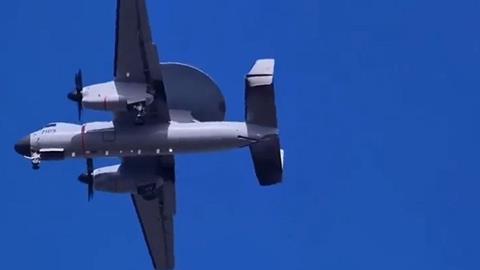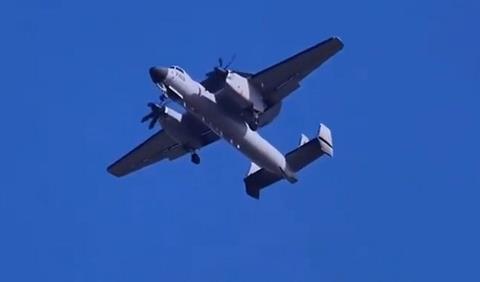The airborne early warning and control (AEW&C) aircraft for China’s next generation aircraft carrier is continuing with flight tests.
Images on Chinese social media sites appear to show the Xian KJ-600 conducting test flights, with the aircraft sporting a grey paint scheme.

It is unknown exactly when – or where – the images were captured. The aircraft is being developed by Xian Aircraft Industrial Corporation in the city of Xian, located in the country’s central Shaanxi province.
In layout the aircraft resembles the Northrop Grumman E-2 Hawkeye, including the four-fin tail found on the American type.
The pictures emphasise a V-shaped recess in the rear fuselage for the aircraft’s arresting hook.
Chinese defence sites suggest that possibly six prototypes are involved in the KJ-600 test campaign.
Apart from rare sightings that are posted on China’s heavily censored Internet, little is known about the KJ-600 – as well as other high profile Chinese aircraft programmes.
It is all but certain, however, that the type features an active electronically scanned array (AESA) radar. At the 2018 Airshow China in Zhuhai, defence electronics firm CETC showed a promotional video where a twin-turboprop aircraft – presumably the KJ-600 – used its KLC-7 AESA radar to direct an engagement against a group of enemy fighters that resembled Boeing F/A-18E/F Super Hornets.

There is also speculation that a carrier onboard delivery (COD) variant is being developed. In the US Navy, COD aircraft such as the C-2 Greyhound and Bell-Boeing CMV-22B tiltrotor ferry important equipment and personnel between land bases and the carrier.
The KJ-600 has been in flight testing since at least August 2020, as China continues work on its third aircraft carrier, CNS Fujian, in Shanghai’s Jiangnam shipyard.
Unlike China’s two in-service carriers, CNS Liaoning and CNS Shandong, which use a ski-jump to launch aircraft, CNS Fujian is equipped with a trio of electromagnetic launch systems (EMALS), allowing it to launch a broader variety of aircraft at heavier payloads.
Yet another unknown about the KJ-600 is whether the aircraft has undergone EMALS or arrested landing tests at a land-based site.
As for CNS Fujian, recent images show that the flight deck has been cleared of structures, most notably three sheds that covered its EMALS systems. It has yet to receive the deck markings required for flight operations. Speculation suggests that sea trials for the vessel could start soon.


























